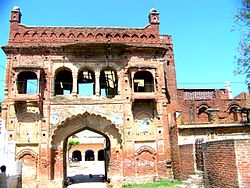Muzaffarnagar district
District of Uttar Pradesh in India From Wikipedia, the free encyclopedia
Muzaffarnagar district is a district of Uttar Pradesh state in northern India. It is part of Saharanpur division. The city of Muzaffarnagar is the district headquarters. This district is the part of National Capital Region.
Muzaffarnagar district | |
|---|---|
 Bada Darwaza in Kakrouli village | |
 Location of Muzaffarnagar district in Uttar Pradesh | |
| Country | |
| State | Uttar Pradesh |
| Division | Saharanpur |
| Headquarters | Muzaffarnagar |
| Tehsils | Sadar, Budhana, Jansath, Khatauli |
| Government | |
| • Lok Sabha constituencies | Muzaffarnagar |
| • Vidhan Sabha constituencies | Muzaffarnagar, Budhana, Charthawal, Khatauli, Meerapur, Purqazi |
| Area | |
| • Total | 2,991 km2 (1,155 sq mi) |
| Population (2011) | |
| • Total | 2,869,934 |
| • Density | 960/km2 (2,500/sq mi) |
| Demographics | |
| • Literacy | 69.12 per cent[1] |
| • Sex ratio | 889/1000 |
| Time zone | UTC+05:30 (IST) |
| PIN | 251 3xx |
| Vehicle registration | UP-12 |
| Major highways | SH59, SH12A |
| Website | muzaffarnagar |
History
Medieval period
Muzaffarnagar's early medieval history is obscure till the Indo-Mughal period. Timur's army had marched to Delhi through this region in 1399; its people fought it unsuccessfully. In Mughal Emperor Akbar's time, most of the Muzaffarnagar district region, called Sarwat then under the Mahal control of Tagas / Tyagis of Sarvat village, belonged to the sarkar (circle) of Saharanpur. Akbar bestowed pargana of Sarwat on Sayyed Mahmud Khan Barha which remained with his descendants up to the 17th century. Munawwar Lashkar Khan Barha established the city and named it Muzaffarnagar in honour of his father, Sayyid Muzaffar Khan, otherwise known as Khan-i-Jahan during the reign of Shah Jahan, after which Sarwat also became Muzaffarnagar.[2][3] At the time Muzaffarnagar was part of the Barah country as it was intimately connected with the Indian Muslim kinship group called the Barah Sayyids,[4][5] who controlled the upper Doab.[6] The Indian Muslim inhabitants of Barah, especially from near the town of Jansath, were heavily recruited in the Army of the Mughal Empire, where they had a hereditary right to lead the vanguard of the imperial troops in every battle.[7][8] The unique privilege of the Barah Sayyids of leading the imperial vanguard also gave them an advantage over other parts of the Mughal military and exalted their sense of social pride.[9] They also made up the personal cavalry of the Sayyid Brothers, both from Muzaffarnagar, who were de-facto rulers of the Mughal Empire in the 1710s.[10][11][12]
Modern era
Muzaffarnagar district gained notoriety in the 20th century with frequent incidents of loot, murders, kidnappings and dacoity.[13]
Blocks
The district is divided into 9[14] blocks, these are:
| Sr. No. | Block Name |
|---|---|
| 1 | Muzaffarnagar Sadar |
| 2 | Budhana |
| 3 | Baghra |
| 4 | Shahpur |
| 5 | Purquazi |
| 6 | Charthawal |
| 7 | Morna |
| 8 | Jansath |
| 9 | Khatauli |
Demographics
| Year | Pop. | ±% p.a. |
|---|---|---|
| 1901 | 867,177 | — |
| 1911 | 799,331 | −0.81% |
| 1921 | 786,187 | −0.17% |
| 1931 | 885,877 | +1.20% |
| 1941 | 1,046,382 | +1.68% |
| 1951 | 1,209,771 | +1.46% |
| 1961 | 1,429,961 | +1.69% |
| 1971 | 1,781,579 | +2.22% |
| 1981 | 2,248,483 | +2.35% |
| 1991 | 2,842,543 | +2.37% |
| 2001 | 3,543,362 | +2.23% |
| 2011 | 4,143,512 | +1.58% |
| source:[15] | ||
According to the 2011 census Muzaffarnagar district has a population of 4,143,512 [16] roughly equal to the nation of Lebanon[17] or the US state of Oregon.[18] This gives it a ranking of 125th in India (out of a total of 640).[16] The district has a population density of 960 inhabitants per square kilometre (2,500/sq mi) .[16] Its population growth rate over the decade 2001-2011 was 16.8%.[16] Muzaffarnagar has a sex ratio of 886 females for every 1000 males,[16] and a literacy rate of 70.11%.[16] Minority population is about 40% of the total population of the district.[16]
The divided district had population 2,869,934 and a sex ratio of 893 females per 1000 males. 805,210 (28.06%) lived in urban areas. Scheduled Castes made up 419,987 (14.63%) of the population respectively.[16]
At the time of the 2011 Census of India, 86.28% of the population of the district spoke Hindi and 13.29% Urdu as their first language.[20]
Education
Villages
Town
References
External links
Wikiwand in your browser!
Seamless Wikipedia browsing. On steroids.
Every time you click a link to Wikipedia, Wiktionary or Wikiquote in your browser's search results, it will show the modern Wikiwand interface.
Wikiwand extension is a five stars, simple, with minimum permission required to keep your browsing private, safe and transparent.
